The United Kingdom again took top honors in Europe’s facilities race, attracting some 508 major investments.
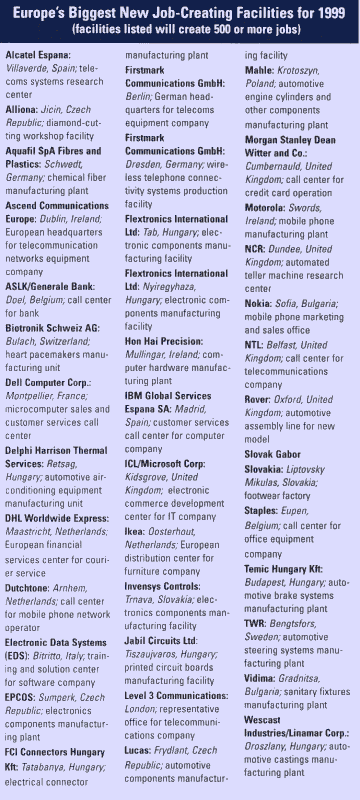
The United Kingdom attracted more new and expanded corporate facilities in 1999 than any other European country. France took the runner-up position, while Germany ranked third.
Those results are essentially a photocopy of 1998’s facilities race, in which the same three countries took the top three spots, based on Ernst & Young’s European Investment Monitor (EIM) database — the world’s best source of data on European facility-location activity. The EIM recorded some 2,136 new and expanded corporate facility investments across Europe (see sidebar article for more information on the EIM).
A closer look at 1999’s corporate expansion map, though, suggests that undercurrents of change are swirling.
“I think there is a repositioning going on in Europe,” says Barry Bright, London-based director of Ernst & Young’s International Location Advisory Service. “The UK, a traditionally strong country, and recently strong performers, such as central and eastern Europe, have [declined] a bit. But other players, such as France and Spain, are coming through more strongly. That raises major questions over the European monetary union (EMU).” The United Kingdom, of course, has chosen not to participate in European monetary union.
Indeed, the number of projects in EMU countries increased by 10 percent last year. But corporate facility investments in non-EMU countries declined by about 20 percent. “Certain countries both in and out of the EMU bucked that trend, but still it’s a pretty significant development,” Bright emphasizes. “But the UK is still No. 1.”
The other big trend that emerged last year is the growing impact of the e-economy, expressed in several different ways. “First, the proportion of manufacturing projects has declined,” Bright reports. “Second, software is now the largest sector, and it’s growing very, very fast. The leading investors now include people involved in the technology process, like Nokia, Motorola, Ericsson and so on. And there are a lot of dot-coms scattered around.”
Germany as a source of investments is coming back, Bright says, and within central and eastern Europe it’s now a larger source than the United States. “There are several reasons for that,” he explains. “First, there is border hopping to obtain lower costs. Second, there is a genuine desire among many companies to move their focus eastward. And then Germany has a lot of mid-sized companies (as opposed to very big or very small companies) that will move, but not too far away.”
Looking ahead to key trends that could affect companies’ future European location decisions, Bright suggests increased tax competition among European countries could result from monetary union.
“At the country level, if you’re within EMU, you have few other available economic instruments,” he points out. “You don’t have exchange rate, and you don’t have interest rate. All you’ve got are supply issues, fiscal policy and then tax. Of those, the only thing that translates through into international competition is tax. At the same time, though, the European Union wishes to eliminate tax competition. So there could be some interesting debates coming up in places like the Netherlands, Belgium and Ireland.”
Another issue — one that’s probably even more important in influencing where companies establish operations — is that a lot of very successful cities are now struggling to accommodate new projects. And that’s opening the door for new players.
“People are looking at a greater range of cities now,” Bright says. “Barcelona (Spain) is now on that list, but it wouldn’t have been there five years ago. Lyon (France) is another example, as are Stockholm (Sweden), Copenhagen (Denmark) and Berlin. Another more extreme example of this trend is Budapest (Hungary), which we are now looking at for multilingual services facilities serving western Europe. That would never have been possible three years ago. There are some very interesting new arrivals, and we expect to see more of those.”
Italy still remains a puzzle, Bright observes. “It has a great economy, very high GDP, good technology and good firms, but very little investment. It’s almost the ‘missing player’ in Europe. France is coming back, and Spain is moving up, but there continues to be a dichotomy between Italy’s industrial structure and the amount of investment it gets. That has to be one of the biggest question marks over the long-term investment pattern in Europe.”
Furthermore, Sweden merits special mention as an up-and-coming player that has done extremely well of late in attracting new business. “It’s got a combination of excellent technology, both infrastructure and people, and an improved cost base,” Bright says. “It’s a more welcoming economy, with lower taxes, compared to what it was five years ago. And the Invest in Sweden Agency has done an excellent job.”
Other major findings include:
• ICL and Siemens were the most active firms in launching European facility investments last year, each announcing 12 new or expanded projects. Other active firms include Nokia (11 facilities), DHL (10), Motorola (8) and Coca-Cola, Opel and Volvo (each with 7 facilities).
• Greater London took top honors as Europe’s No. 1 region for new and expanded facilities, attracting 136 investments (see chart). Rounding out ’99’s top five were Ile-de-France (e.g., the Paris region), with 74 facilities, followed by Cataluna, Spain (73) and Alsace, France, and Hessen, Germany (each with 54).
• In terms of new manufacturing plants, Cataluna, Spain, came out on top among European regions with 14 new factories. Other leading regions include Stredocesky Kraj, Czech Republic (10 plants), Moscow (8) and Pest, Hungary (7).
• London came out on top among European cities, luring 110 new and expanded facilities. Next were Paris (43), Frankfurt, Germany (40), Dublin, Ireland (38) and Barcelona, Spain (35).
• The United Kingdom made the call-center connection more often than any other country, landing 27 new facilities last year. Chasing the UK were Ireland (15), Germany (13), the Netherlands (10) and France (9).
• U.S. firms remained the leading non-European source of facility investments, accounting for almost 900 projects. Following were Japan (148 projects) and Canada (54). Worthy of mention among up-and-coming investor nations tapping into Europe’s huge marketplace is India, which is loaded with growing high-tech companies.
Here’s additional information on 1999’s winners in the European facility-location competition.
United Kingdom Repeats As European Champ
In fact, the United Kingdom ranked No. 1 in all major investment categories tracked by the EIM save one: distribution centers. The country’s 25 distribution centers took the No. 3 ranking.
London emerged as Europe’s top city, with 110 new and expanded facilities, while the Greater London region topped all regions with 136 projects.
France No. 2 Again,
But Gaining Ground
France took the overall No. 2 ranking in 1999 — the same as the previous year. But it attracted 391 new and expanded facilities, well above its ’98 performance (271 investments).
France bested all European competitors in the hunt for distribution centers, attracting 37 facilities.
Germany Takes Third
Not only are German firms’ real estate and facilities investments in other European countries on the rise, Germany itself continues to be a favored investment location.
Europe’s biggest market won 195 major new and expanded facilities last year, taking the No. 3 ranking overall. Germany also took the No. 2 ranking in both headquarters facilities (17 investments) and customer service/marketing facilities (85).
Spain’s Big Move
Up to No. 4
Spain wins honors for making the biggest move up the charts in 1999. Its 139 new and expanded facilities earned it the No. 4 ranking among European countries — a big improvement over its 1998 performance, when its 90 facilities earned the No. 8 ranking.
Spain’s Cataluna region lured more new manufacturing plants than any other European region last year (14), and it grabbed the No. 3 ranking among regions for new and expanded facilities overall (73 facilities).
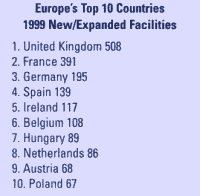
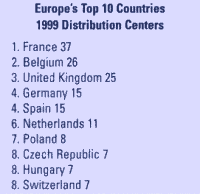
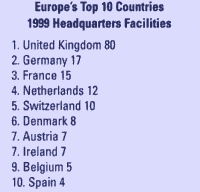
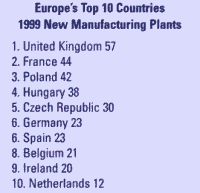
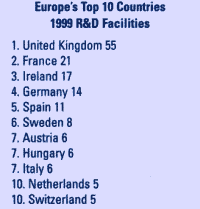
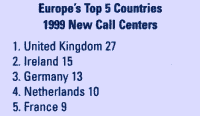
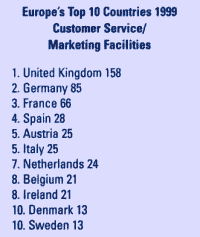
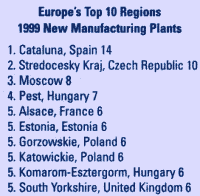
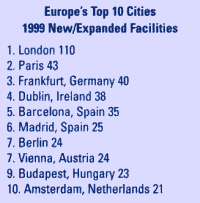
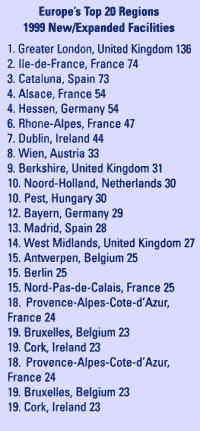
Ireland, No. 5
Ireland continues to have an outsized presence in European location activity. Companies tapped Ireland for some 117 new and expanded facility investments in 1999.
Ireland’s performance in R&D centers and call centers was particularly strong, and only London, Paris and Frankfurt, Germany lured more projects than the city of Dublin (38 facilities).
Belgium Grabs
Sixth Place
Belgium turned in another top performance in 1999, attracting 108 new and expanded facilities.
The country was particularly competitive in winning distribution centers (26 facilities), more than any country except France.
Hungary, No. 7
Hungary’s No. 7 ranking for 1999 matched its ’98 performance, but its 89 new and expanded facilities were fewer than the 114 it lured the prior year.
Hungary’s 38 new manufacturing plants earned it the No. 4 ranking in Europe. In fact, two of Europe’s top 10 regions for new manufacturing plants are in Hungary.
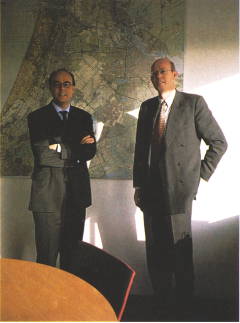 Netherlands, No. 8
Netherlands, No. 8
The Netherlands came in No. 8 in Europe’s 1999 facilities race, up one notch from its 1998 ranking.
Headquarters facilities (the No. 4 ranking), call centers (also No. 4) and distribution centers (the No. 6 ranking) are particular strengths for the Netherlands. The Amsterdam area continues to be a hot spot for major investments of all kinds.
RIGHT: Willem M. Trommels (left) and Ton J. van Weers can provide valuable assistance to companies exploring business opportunities in and around Amsterdam’s Schiphol Airport.
Austria Takes Ninth Spot
Austria moved up one notch in 1999 to No. 9, landing 68 new and expanded facilities.
The mountainous country made its biggest mark in customer service/marketing facilities, tying with Italy for the No. 5 ranking with 25 investments.
Poland Falls to No. 10
Poland tumbled to No. 10 in the 1999 facilities race, landing 67 major corporate investments — well below its ’98 performance, in which 117 facilities propelled the central European country to the No. 5 ranking overall.
Poland, though, continues to be particularly favored as a manufacturing site. Only the United Kingdom and France attracted more new factories than Poland’s 42 new plants.

